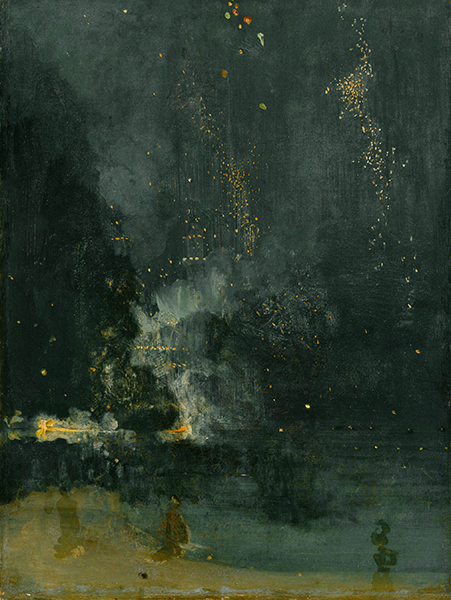19th Century Poet and Novelist Theophile Gautiers Idea of Art for Arts Sake Meant That
The early 19th century was marked past the two dominating, all the same opposing tendencies - Romanticism and Neoclassicism. Nonetheless, when it comes to the field of art theory, the phenomenon that encapsulated the zeitgeist of this era was Art for Fine art'due south sake, the English translation of l'fine art pour l'art, a French slogan that expresses the philosophic proffer that art should be deployed of any moral, political or utilitarian connotation.
The artworks produced under the influence of this belief were perceived as true art, art that is self-sufficient, complete in itself, morally neutral, or subversive.
Fine art for art's sake advocated for the primacy of aesthetic value and elements inherent to a work of art such as color, form, line, shape, infinite, and limerick. This persuasion didn't just become central to the British Artful motion, but it also took over and made a huge impact on the later development of 20th-century art; it provoked different debates focused on the very notion of an artwork and the autonomy of art. For that reason, different stylistic preoccupations such as modernism and the avant-garde were tackled by Fine art for fine art's sake, even so perpetuating the same patterns in gimmicky art of today.
The Rebellious Nature of Art For Art'south Sake
The original phrase l'art pour l'fine art was coined by the French poet Théophile Gautier (1811–1872), who used it in the preface to his 1835 book, Mademoiselle de Maupin. All the same, he was not the first one to use this formulation, as it was already present in the works by distinguished figures such as the philosopher and the founder of Eclecticism Victor Cousin, Benjamin Constant, political activist and writer on political theory, and the famed American author, Edgar Allan Poe. The concept was embraced by many French, British and American writers, and artists, and by proponents of the Aesthetic Motion such as Walter Pater; one of the leading advocates of Fine art for Art's sake was the American painter James McNeill Whistler.

The Aesthetic Purists Throughout The Time
The 20th century was marked past the appearance of a new generation of modern artists willing to radicalize what the older Modernists, who grew into conservative academic painters, were unwilling to change. They explored virtuous representations aimed to express practiced moral values, desirable conduct, and noble sacrifice, all unacceptable to the radical modernists who considered them uncritical.
While the conservatives wished to maintain existing positions within the institutions, the younger modernists were disquisitional of political and religious institutions since they restricted individual liberties. The old ideas inherited from the Enlightenment were no longer valid, and the modify was only possible if all authority was questioned - particularly in the terms of the centre class. Therefore, the advanced blossomed, exploring political and social issues that the younger artists felt the urge to address.
Art For Art's Sake – A Affair of Privilege
Whistler himself believed he was against the tastes and ideas of the middle form, but this persuasion quickly turned to the neutralization of whatsoever particular content and led to formalism – the need to address issues solely reserved for the art-making procedure. That is how the quest of investigating the pregnant and purpose of art in regards to society became easily ignored.
This 19th-century bohemian's credo was disputed by many, from John Ruskin to the figures who were inclined to the Marxist approach to art-making. Already in 1872, the author George Sand claimed the Fine art For Art's Sake is an empty phrase while insisting that the artists are obliged to communicate their deeds with a wider public. The distinguished German language philosopher Walter Benjamin critically examined the slogan in his iconic 1936 essay The Work of Fine art in the Historic period of Mechanical Reproduction.
Although widely debated, Art For Art'south Sake was mostly embraced by Abstruse artists who were expressing themselves in a closed formalist framework that was separated from the existent world. Such a paradigm was extended on the calibration from the interwar brainchild through the post-war tendencies such as Abstract Expressionism and Color Field painting to Minimalism and some later artistic styles.
Despite the fact various art movements agile during the first half of the 20th century attempted to dissolve the formalist tendencies, the art system itself (governed past the academic art historians and critics, and the sprawling art market interested in profit) eventually absorbed all subversive inclinations and made the Art For Fine art's Sake into a rather neutral activity.
Looking from the contemporary perspective, the Art for Art's Sake approach is retrograde and does nothing in establishing a dialog with a wider customs equally information technology addresses but the ones affiliated with arts. Although cherished by numerous artists, art historians, and the art market, the Art For Fine art'southward Sake is very problematic in the terms of class.
Since the capitalist matrix not only tends to maintain the form discrepancy but rather to deepen it, this image becomes even more questionable, not to mention the fact it means cipher in other cultural environments, being an exclusively Eurocentric creation.
Featured epitome: Marcel Duchamp - Fountain, 1917. Prototype by fine art@aditi via Flickr.
Source: https://www.widewalls.ch/magazine/art-for-arts-sake
0 Response to "19th Century Poet and Novelist Theophile Gautiers Idea of Art for Arts Sake Meant That"
Post a Comment